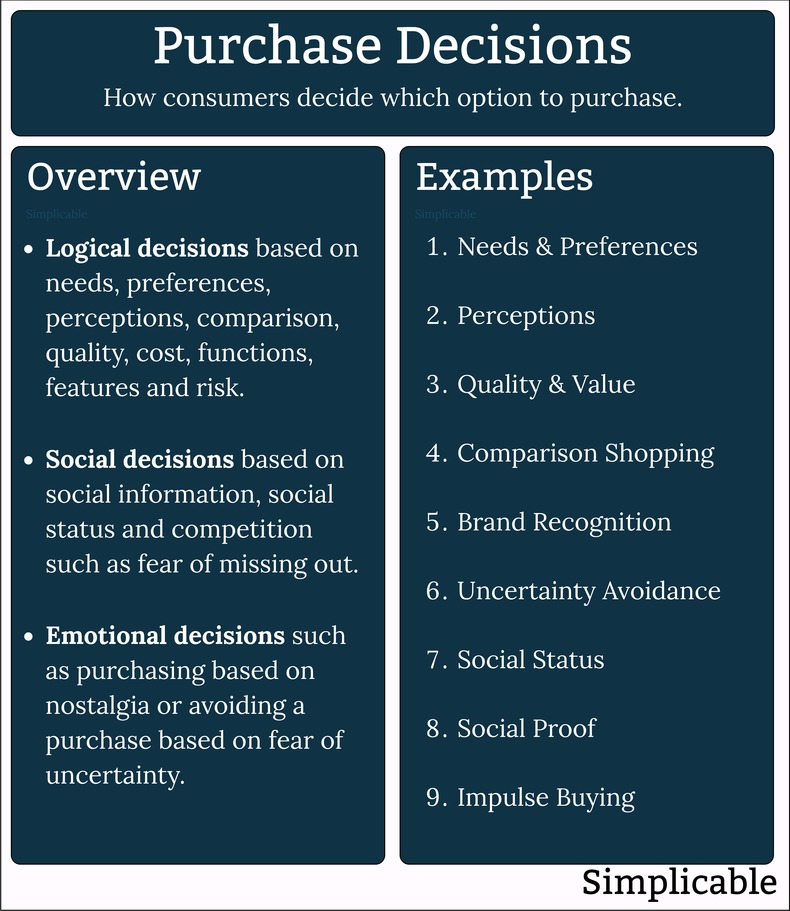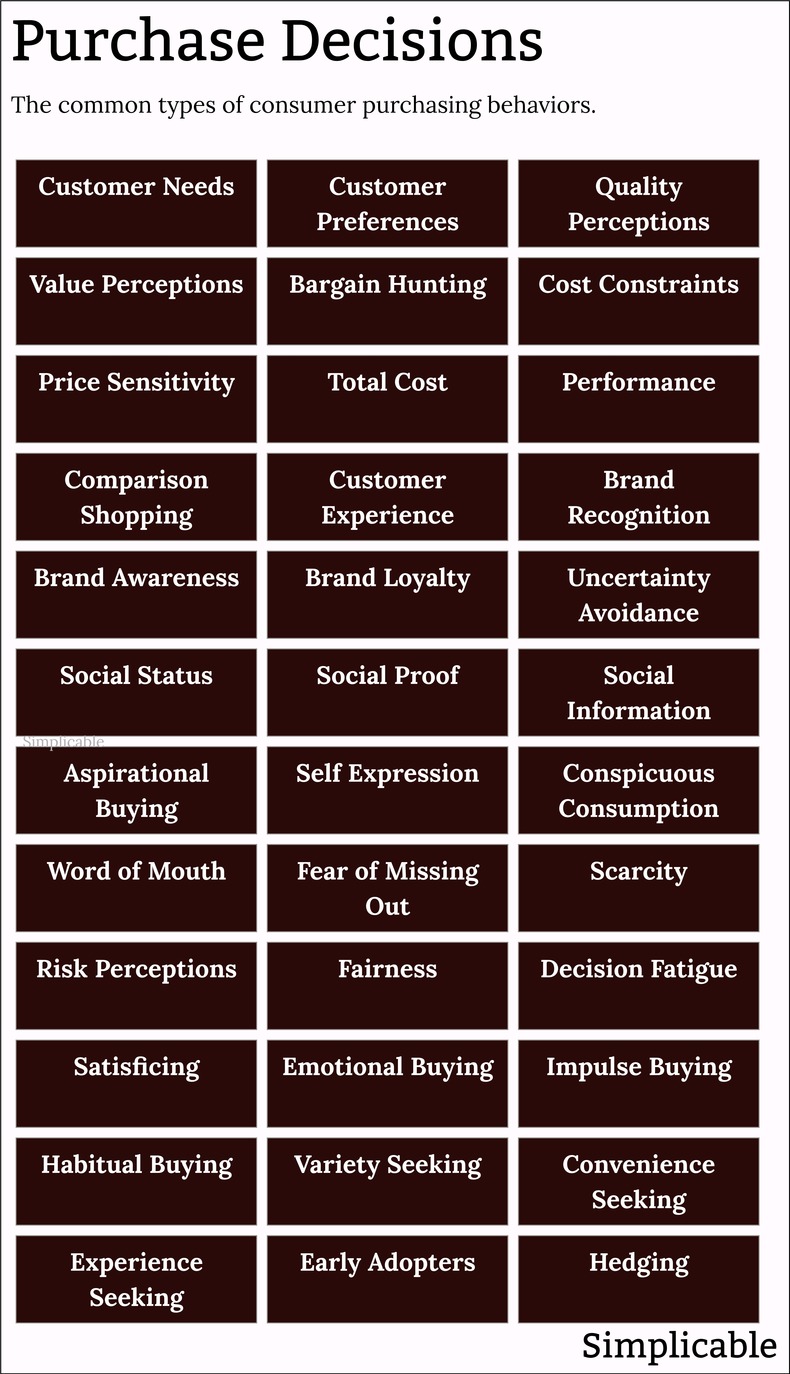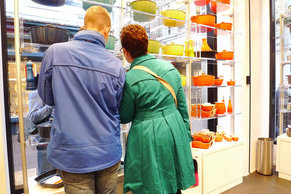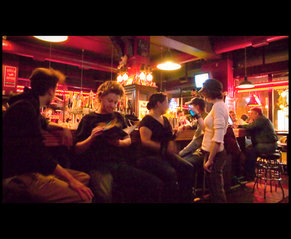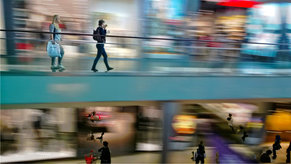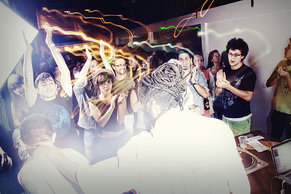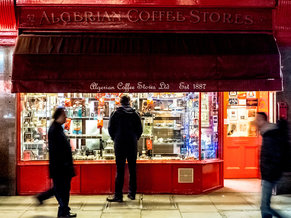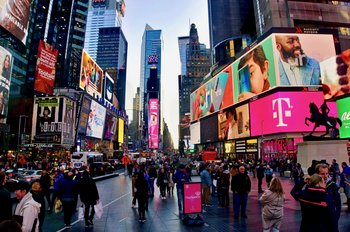|
| |
Purchase decisions are the processes that individuals use to choose between options in a crowded market of goods and services. Making reasonable purchase decisions is a life skill that can benefit from looking at the various ways that consumers make decisions in the real world. This is also of interest to marketing and sales pursuits in order to shape brands, products and offers. The following are common examples of purchase decisions.
Customer NeedsPurchasing the option that has the functions and features you require.Customer PreferencesPurchasing the option that conforms to your preferences such as the color you prefer.Quality PerceptionsPurchasing based on perceptions of quality such as a consumer who views food products with all natural ingredients as being higher quality.Value PerceptionsPurchasing an option that appears to be a good value relative to cost.
Bargain HuntingSeeking out sales and extraordinary offers.Cost ConstraintsPurchasing the best option you can afford.Price SensitivityConsumers can be sensitive to prices for one type of good but price insensitive for another type. For example, a snowboarder who always buys the cheapest socks but will easily purchase an expensive snowboard.Total CostConsumers may consider total cost of ownership such as an ink tank printer that is expensive but has far cheaper ink.PerformancePurchasing based on a figure of merit that indicates the performance of a product.Comparison ShoppingLogically comparing options to consider which is the best based on criteria such as cost, quality, performance, risk and functionality.Customer ExperiencePurchasing an option based on a previous positive experience or avoiding an option based on a bad customer experience.Brand RecognitionConsumers may feel better purchasing brands that they recognize even where they have no specific information about that brand.Brand AwarenessPurchasing based on something you know about a brand such as purchasing a vehicle you have heard is safe.Brand LoyaltyThe conviction that a brand is preferable such that you will not purchase if that brand isn't available.Uncertainty AvoidanceConsumers may avoid options that are missing information or that involve future uncertainty.Social StatusPurchasing goods and services that represent social status such as wealth, coolness or youthfulness.Social ProofBuying an option that you know is popular or that people you admire have purchased.Social InformationSeeking out social information such as ratings and reviews.Aspirational BuyingPurchasing things based on who you want to be. This can involve social status or some type of lifestyle change or life ambition.Self ExpressionPurchasing an option that expresses your character or style.Conspicuous ConsumptionPurchasing something you feel makes you a good person.Word of MouthChoosing an option based on a recommendation from someone.Fear of Missing OutPurchasing things based on trends and popularity for fear of missing out on social change or shared experiences.ScarcityPurchasing things because you think they are in short supply.Risk PerceptionsChoosing an option that appears to be low risk such as a free trial offer that you can cancel at any time.FairnessPurchasing the option you believe is the most fair such as the service that doesn't have unfair terms.Decision FatigueMaking poor decisions or failing to make a purchase decision due to information overload such as excessive product variety.SatisficingChoosing an option that appears to be "good enough" without overthinking it. Satisficing is a common behavior that often involves purchasing a recognizable brand or popular item.Emotional BuyingPurchases driven by emotion such as feelings of nostalgia for your youth.Impulse BuyingPurchasing based on a strong motivation. Implies a decision is irrational such as overspending or purchasing too many sweets.Habitual BuyingRepurchasing the product you have always purchased.Variety SeekingRegularly trying new products or versions in some category. For example, a consumer who is always trying new shampoos.Convenience SeekingChoosing the path of least resistance by purchasing the option that makes things easier.Experience SeekingChoosing options that will represent epic experiences. For example, renting a sports car that you wouldn't ordinarily have the chance to drive.Early AdoptersConsumers who are enthusiastic about a particular good or service such that they will purchase the newest thing.HedgingPurchasing multiple options to spread out the risk.OverviewPurchase decisions have three primary types whereby consumers may be rational, social or emotional in their decisions. Rational decisions involve decision criteria and comparison of options. Social decisions involve social information such as word of mouth and are driven by social competition such as seeking social status. Emotional decisions are based on positive feelings such as wanting to express your personal style or negative feelings such as fear of uncertainty.SummaryThe following are common examples of how purchase decisions are made by consumers.
Consumer BehaviorThe following are further examples of consumer behavior.If you enjoyed this page, please consider bookmarking Simplicable.
© 2010-2023 Simplicable. All Rights Reserved. Reproduction of materials found on this site, in any form, without explicit permission is prohibited.
View credits & copyrights or citation information for this page.
|

